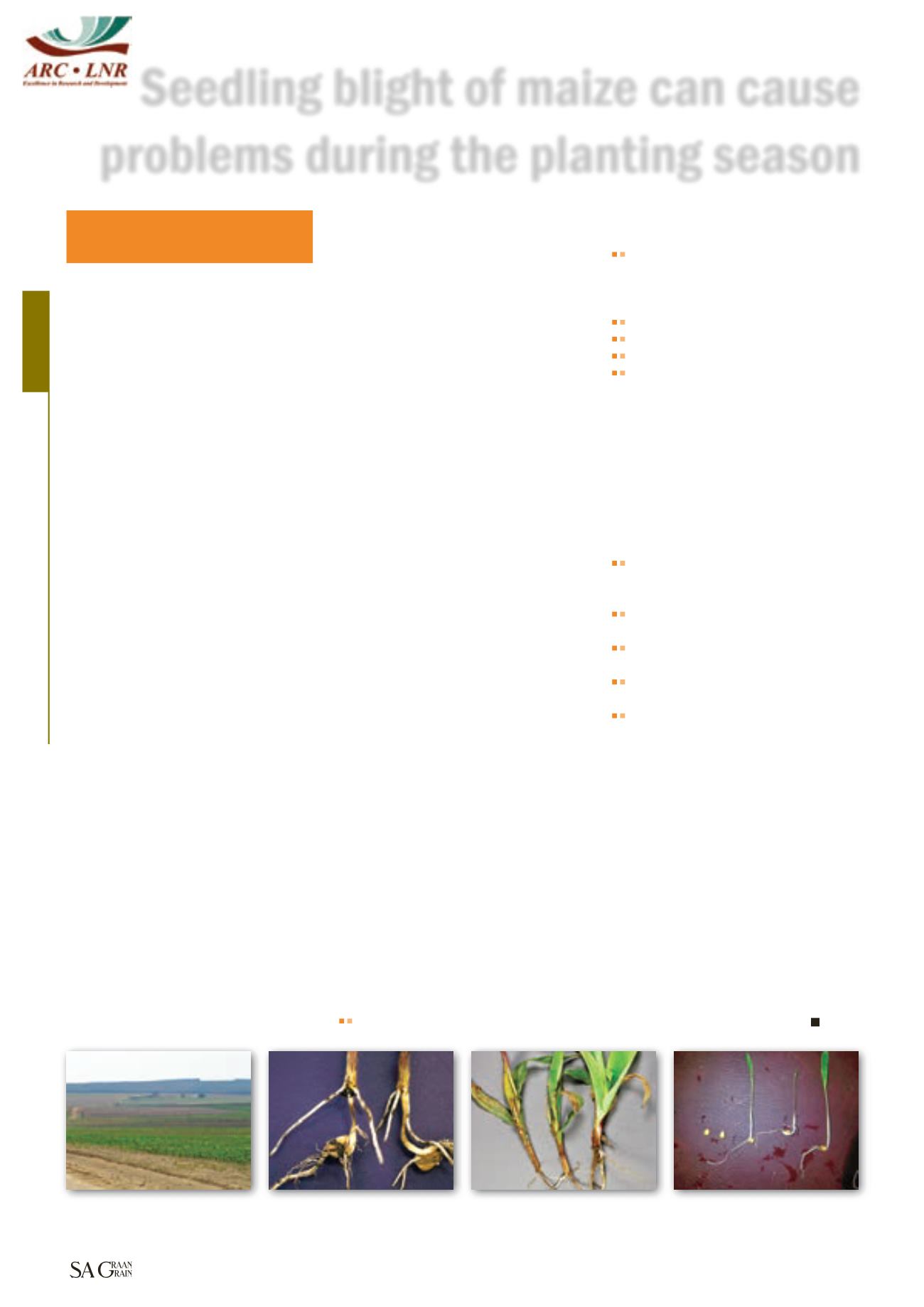
Disease
Inputs/Production
Desember 2013
28
Seedling blight of maize can cause
problems during the planting season
JOHNNY VIVIERS, NORTH-WEST UNIVERSITY, PROF
BRADLEY FLETT AND DR BELINDA JANSE VAN
RENSBURG, ARC-GRAIN CROPS INSTITUTE
Seedling blight of maize has become a
significant problem in some parts of the
country where maize is cultivated. Little has
been reported on maize seedling blight in
South Africa and the full impact of this disease
complex warrants more attention.
Seedling blight affects the maize plant density,
seedling vigour and may have an effect on
yield. In many cases producers have to replant
fields due to poor emergence from seedlings
which results in a financial loss.
What is seedling blight
complex of maize?
Seedling blight is a disease caused by a
combination of different species of fungi
(complex) that is found in the soil, under
different environmental conditions. Disease
severity may vary between localities due to
different soil types, soil moisture levels, soil
temperatures, soil biology and soil nutrition
imbalances.
The fungi involved in seedling blight include
Pythium
,
Fusarium
,
Rhizoctonia
,
Aspergillus
,
Penicillium
and
Trichoderma
spp. The fungi
are abundant in the soil, however spores
of
Clonostachus
,
Verticillium
,
Curvularia
,
Acremonium
and
Bipolaris
spp. are also found
throughout soils in South Africa.
Environmental impact on
disease development
Spores of several of these fungi all require
suitable environmental conditions to germinate
and infect germinating maize seedlings.
Depending on the species, some spores might
require high soil temperatures while others
require moderate to low temperatures.
Temperature and the availability of water and
nutrients seem to have pronounced effects,
alone or in combination, on the susceptibility
of maize seedlings to disease. For instance
weather conditions, particularly wet and cold
conditions, during and after planting, as well
as waterlogged soil, play a major role in the
development of the seedling blight complex.
Seedling blight
development
When seeds get planted early in the season
when soil temperatures are below 15°C, the
metabolism rate of seedlings during the
germination phase is extremely slow. Seeds
absorb water from the soil which can cause
embryo tissue to rupture.
Early season low temperatures delay mem-
brane repair, whereas under warmer soil
temperatures, damage is limited. Damaged
membranes leak carbohydrates and proteins
into the soil which help the spores that are
present in the soil with sporulation. The fungal
mycelium will penetrate the roots to access
nutrients, leading to more cell damage which
results in secondary infections by bacteria and
other fungi.
Symptoms above and
beneath soil level
Areas of low plant stand where seed did not
germinate may be an indication of seedling
blight problems (
Photo 1
). Seeds that did not
germinate will show evidence of rot. Seeds will
be discoloured and soft and occasionally may
have fungal growth all over the roots (
Photo 2
).
When seedlings do emerge from the soil they
tend to be yellow in appearance, wilted and
more prone to die (
Photo 3
). The mesocotyl
will have discoloured, sunken lesions.
Control
The effective control of maize seedling blight is
difficult to achieve mainly because of the wide
spectrum of pathogens associated with the
disease complex. Alternative measures have
been sought in agricultural practices:
Ensure a fine and even seedbed to provide
consistent depth and optimum conditions
for germination.
Avoid planting when soil temperatures
are below 15˚C. If seeds are treated, the
fungicide will be effective for 10 to 14 days.
Plant cultivars with good seedling vigour.
Plant high quality seed.
Plant fields with better drainage first.
Ensure the soil pH is optimal.
Ensure effective herbicide application.
Incorrect application is a major cause of
poor stand establishment and predis-
position to pathogens.
Seed treatment
Seed treatment is the use of specific chemical
and biological products to improve the growth
conditions for the seed, seedling and young
plant. Fungicide seed treatments are primarily
used for the following:
To control soil borne fungal disease
organisms that cause seed rots, damping-
off, seedling blight and root rot.
To control fungal pathogens which are
surface borne on the seed.
To control internal seed borne fungal
pathogens.
To control some diseases of seedlings or
young plants (leaf rust).
Seed treatment plays a big role in the
seedling germination process. Treated
seeds result in improved stand and
survival throughout the critical stages of
maize seedling development (
Photo 4
).
Collaborative research done by the ARC-Grain
Crops Institute (ARC-GCI) and the North-
West University (NWU) is being conducted
on seedling blight of maize to determine the
extent of the problem as well as the different
fungi involved in the complex. Screening of
potential seed treatments to control seedling
blight, is ongoing.
For further information, please contact
Johnny Viviers at the NWU, Prof Bradley Flett,
Dr Maryke Craven or Dr Belinda Janse van
Rensburg (ARC-GCI) at 018 299 6100.
Photo 1: Poor seedling stand indicat-
ing possible seedling blight.
Photo 2: Discoloration of seedling
stems and roots, which has been in-
fected by the seedling blight complex.
Photo 3: Emerged seedlings with a
yellow, rotted appearance.
Photo 4: Seedlings of the same age;
the middle one without seed treat-
ment.


